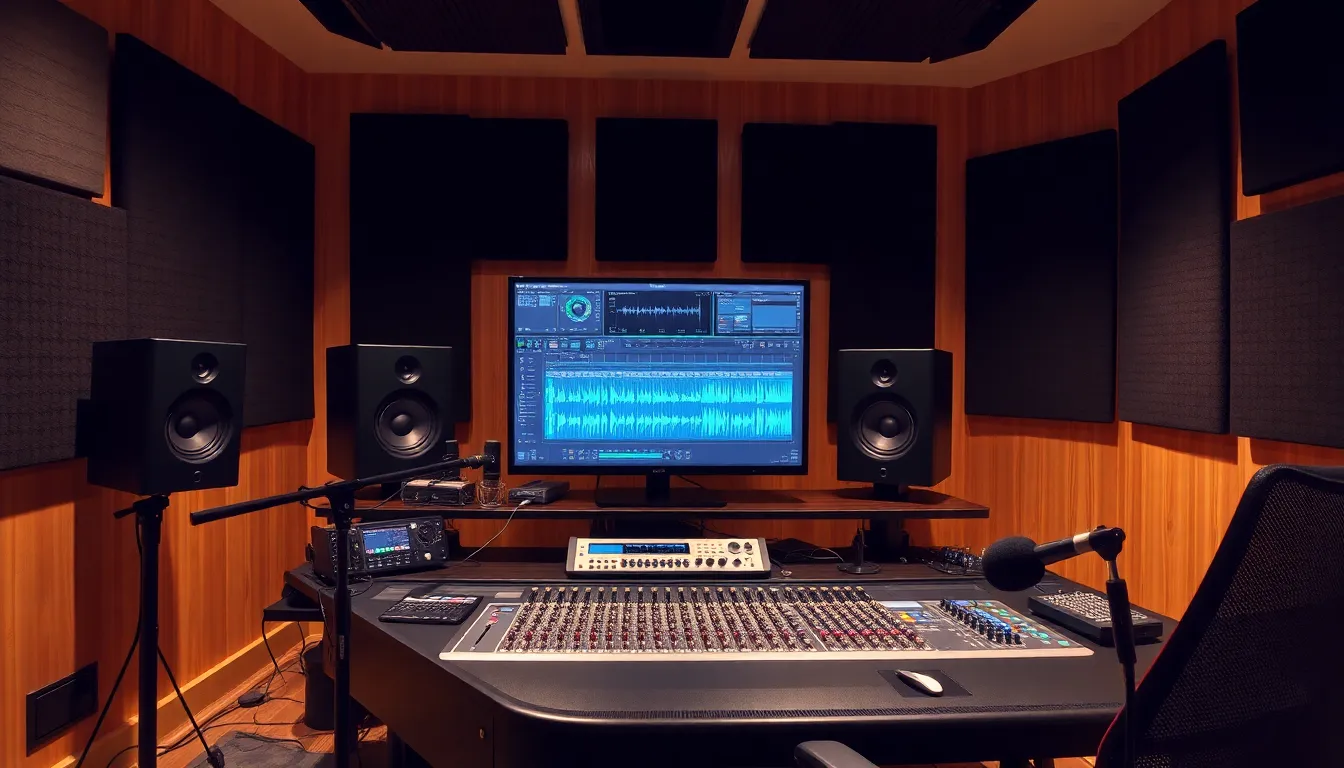In the ever-evolving world of music, production techniques play a crucial role in shaping the sound of today’s hits. From layering tracks to manipulating audio effects, these methods not only enhance creativity but also elevate the overall listening experience. Understanding these techniques can empower aspiring producers and seasoned musicians alike to craft their unique sound.
Whether it’s the art of sampling or the science of mixing, mastering the fundamentals of music production can unlock endless possibilities. As technology advances, new tools and software emerge, making it easier than ever to experiment and innovate. Dive into the world of music production techniques and discover how they can transform raw ideas into polished tracks that resonate with audiences everywhere.
Music Production Techniques
Music production techniques play a crucial role in crafting compelling soundscapes. Producers often implement several methods to create unique auditory experiences.
Layering Tracks
Layering tracks involves stacking multiple audio recordings to create a fuller sound. Producers can use different instruments or vocal harmonies to enhance a track’s depth. For instance, combining acoustic and electronic elements results in a rich, textured sound.
Manipulating Audio Effects
Manipulating audio effects offers endless creative possibilities. Producers utilize tools like reverb, delay, and distortion to shape sound characteristics. For example, applying reverb can create an ambient atmosphere, while distortion can add grit and intensity to guitar recordings.
Sampling
Sampling allows producers to incorporate existing sounds into new compositions. They can extract snippets from other songs, vocal tracks, or sound effects. By manipulating these samples through techniques like chopping and stretching, producers create fresh and innovative sounds.
Mixing
Mixing is the process of balancing various audio elements for clarity and coherence. Producers adjust levels, panning, and EQ settings to ensure each instrument and vocal complements the others. Effective mixing can vastly improve the final product’s overall impact.
Utilizing Technology
Advancements in technology have expanded the toolkit available to music producers. Digital audio workstations (DAWs) like Ableton Live and Pro Tools provide essential features for recording, arranging, and editing music. These platforms also offer a range of plugins and virtual instruments that aid in producing high-quality tracks.
Understanding these techniques enables both aspiring producers and seasoned musicians to enhance their work significantly. By exploring these methods, they can transform raw ideas into polished tracks, capturing listener attention and fostering a deeper connection with audiences.
Essential Tools for Music Production

Understanding the essential tools for music production enhances the creative process and improves the quality of sound. Key equipment ensures effective recording, editing, and mixing of music.
Digital Audio Workstations (DAWs)
Digital audio workstations (DAWs) serve as the core software for music production. DAWs provide functionalities for recording, editing, and arranging audio tracks seamlessly. Popular options include Ableton Live, Logic Pro, and Pro Tools, each offering unique features that cater to various production styles. DAWs support MIDI sequencing, which allows for precise control over virtual instruments and samples. They also include built-in effects and plugins, enabling further sound manipulation. Understanding the interface and functionality of a chosen DAW is crucial for maximizing productivity and creativity in the music-making process.
Audio Interfaces and Microphones
Audio interfaces and microphones enable high-quality sound capture essential for music production. Audio interfaces convert analog signals from instruments or vocals into digital format, allowing for clearer recordings. Key features to consider include the number of input/output channels, connectivity options, and sample rates. Popular brands include Focusrite, PreSonus, and Universal Audio. Microphones vary in type—dynamic and condenser microphones—each suited for specific recording situations. Proper microphone selection caters to the sound source, ensuring the best audio fidelity. Investing in reliable audio interfaces and microphones significantly enhances overall sound quality in music projects.
Recording Techniques
Recording techniques play a crucial role in capturing high-quality audio and enhancing the overall production process. Effective methods elevate both vocal and instrumental recordings, ensuring clarity and richness in sound.
Vocal Recording Tips
Vocal recording involves several key practices that maximize sound quality. Use a pop filter to reduce plosive sounds and improve vocal clarity. Position the microphone at an appropriate distance, typically 6 to 12 inches, to capture the best tonal quality while avoiding distortion. Experiment with microphone placement angles to find the most flattering sound. Ensure the recording environment is treated acoustically to minimize background noise and reflections. Choose a quiet space, free from distractions, to enhance the performance. Utilize headphones to prevent sound bleed during recording sessions.
Instrument Recording Best Practices
Instrument recording requires specific techniques to capture the unique characteristics of each sound source. Select the right microphone type—condenser mics work well for acoustic instruments, while dynamic mics are ideal for loud sources like drums. Place the microphone at strategic positions to capture the instrument’s essence, such as near the soundhole for guitars or above the snare for drums. Utilize direct input (DI) boxes for electric instruments to achieve a clean signal. Monitor levels closely to avoid clipping and ensure a balanced mix. Finally, maintain consistent performance dynamics to provide flexibility during the mixing process.
Mixing Techniques
Mixing techniques play a crucial role in achieving a polished sound in music production. They enhance audio clarity and spatial placement, resulting in a more engaging listening experience.
Equalization (EQ)
Equalization allows producers to adjust the frequency balance of audio tracks. By boosting or cutting specific frequencies, producers create better separation between instruments and vocals. Proper EQ helps eliminate muddiness in sounds, ensuring each element occupies its own frequency range. For example, cutting low frequencies from vocals prevents overlap with bass instruments, enhancing clarity. Using tools like parametric EQ can aid in making precise adjustments for a well-defined mix.
Compression and Effects
Compression controls the dynamic range of audio tracks, balancing loud and soft sounds for a consistent output. It prevents clipping and distortion in louder passages while bringing quieter elements forward. For instance, applying compression to vocals can add sustain and presence, making them sit well in the mix. Additional effects like reverb and delay contribute depth and space to the mix. Carefully applying these effects can enrich the overall sound, adding texture and ambiance without overwhelming the listener.
Mastering Techniques
Mastering techniques play a crucial role in preparing tracks for distribution, ensuring they translate well across various listening environments. Mastering polishes the final mix, enhancing its overall quality.
Finalizing Your Track
Finalizing a track involves several key steps. He or she must assess the overall clarity and cohesiveness of the mix. Apply limiting to maximize loudness without distortion. Analyze the track’s dynamic range to maintain energy, ensuring it matches industry standards. Use reference tracks for comparison to identify any discrepancies in tonal balance. Implementing high-pass filters can clean up unnecessary low-end frequencies, refining the final sound. Export the composition in multiple formats to accommodate different platforms and media.
Understanding Loudness
Understanding loudness is essential for mastering a track effectively. Loudness affects the listener’s perception and experience. Utilize metering tools to monitor perceived loudness, measured in LUFS (Loudness Units Full Scale). Aim for -14 LUFS for streaming platforms, while allowing for slightly higher levels for physical media. Be cautious with peaks; they should stay below -1 dBTP (decibels True Peak) to avoid clipping. He or she must balance loudness against dynamic range, ensuring the track retains emotional impact while being competitive in volume.
Conclusion
Mastering music production techniques can significantly elevate the quality of any project. By embracing methods like layering tracks and effective mixing, producers can create a rich auditory experience that resonates with listeners. Understanding the role of essential tools such as DAWs, audio interfaces, and microphones further enhances the creative process.
Recording and mixing techniques are vital for capturing high-quality audio and achieving a polished sound. With the right approach to mastering, tracks can be fine-tuned for optimal performance across various platforms. As technology continues to evolve, staying informed about the latest advancements will empower producers to refine their craft and connect more deeply with their audience.
